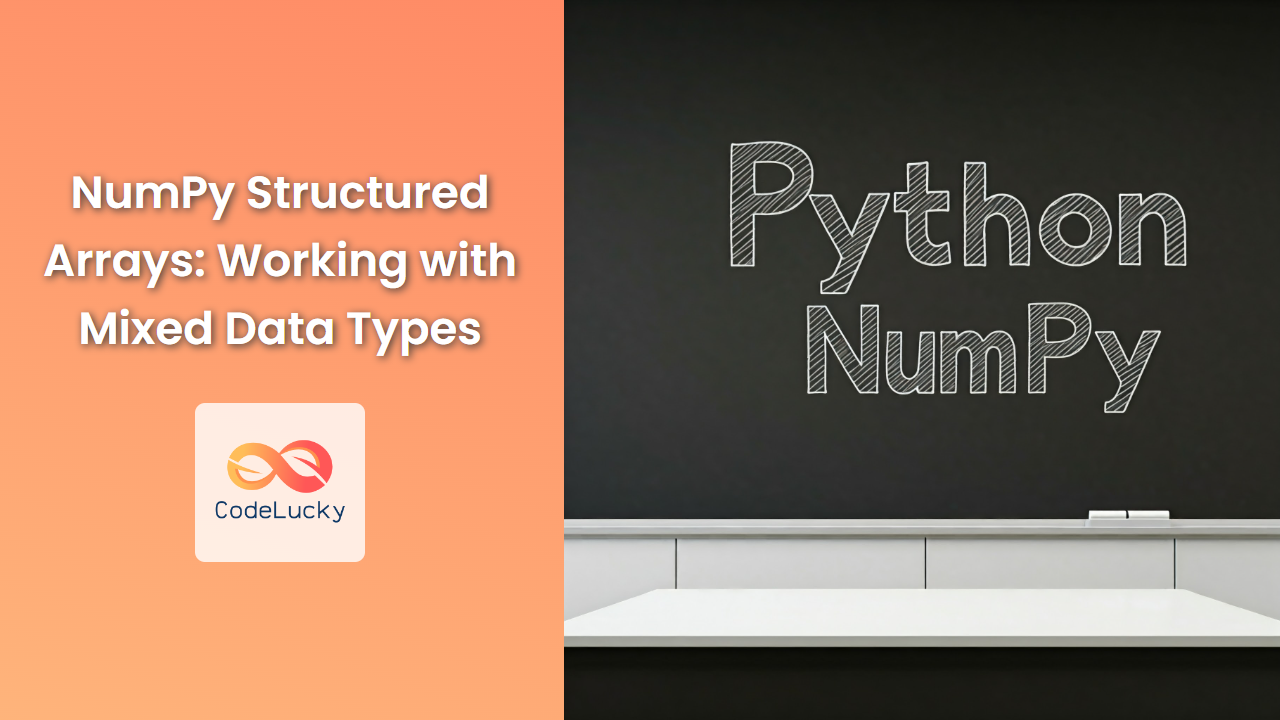NumPy's structured arrays provide a powerful mechanism to handle arrays containing data of different types. This is especially useful when working with data that has multiple attributes, each with a different data type. Let's explore the intricacies of structured arrays in NumPy.
Defining a Structured Array
A structured array is defined using the dtype argument when creating a NumPy array. The dtype specifies the data types and names for each field within the array.
import numpy as np
# Define a structured array with three fields
data_type = np.dtype({'names': ('name', 'age', 'city'),
'formats': ('U10', 'i4', 'U20')})
# Create an empty structured array
data = np.zeros(3, dtype=data_type)
print(data)
[('', 0, '') ('', 0, '') ('', 0, '')]
In this example:
'names': A tuple specifying the field names:name,age, andcity.'formats': A tuple specifying the data types for each field:'U10': Unicode string with a maximum length of 10 characters.'i4': Integer with 4 bytes of storage.'U20': Unicode string with a maximum length of 20 characters.
Initializing Structured Arrays
You can initialize a structured array directly when creating it:
data = np.array([('Alice', 25, 'New York'),
('Bob', 30, 'London'),
('Charlie', 28, 'Paris')],
dtype=data_type)
print(data)
[('Alice', 25, 'New York') ('Bob', 30, 'London') ('Charlie', 28, 'Paris')]
Accessing Data in Structured Arrays
Data within a structured array can be accessed using field names:
print(data['name'])
['Alice' 'Bob' 'Charlie']
print(data['age'])
[25 30 28]
print(data['city'])
['New York' 'London' 'Paris']
Modifying Data in Structured Arrays
You can modify data within a structured array by assigning values to individual fields:
data['age'][0] = 26
print(data)
[('Alice', 26, 'New York') ('Bob', 30, 'London') ('Charlie', 28, 'Paris')]
Creating Structured Arrays from Lists and Dictionaries
Structured arrays can also be created from lists and dictionaries:
names = ['Alice', 'Bob', 'Charlie']
ages = [25, 30, 28]
cities = ['New York', 'London', 'Paris']
data = np.zeros(3, dtype=data_type)
data['name'] = names
data['age'] = ages
data['city'] = cities
print(data)
[('Alice', 25, 'New York') ('Bob', 30, 'London') ('Charlie', 28, 'Paris')]
data_dict = {'name': ['Alice', 'Bob', 'Charlie'],
'age': [25, 30, 28],
'city': ['New York', 'London', 'Paris']}
data = np.zeros(3, dtype=data_type)
for field in data.dtype.names:
data[field] = data_dict[field]
print(data)
[('Alice', 25, 'New York') ('Bob', 30, 'London') ('Charlie', 28, 'Paris')]
Practical Use Cases
Structured arrays are highly beneficial in various scenarios:
- Data Analysis: Representing data with different attributes, like customer demographics, sensor readings, or financial records.
- Scientific Computing: Storing experimental data with labels and units.
- Game Development: Representing game objects with properties like position, velocity, and health.
Advantages of Structured Arrays
- Data Organization: Structured arrays promote a structured approach to handling data, making it more organized and easier to manage.
- Efficient Data Access: By utilizing field names, data access is optimized, allowing for faster retrieval of specific data points.
- Type Safety: Enforces data types for each field, ensuring data integrity and preventing type-related errors.
Performance Considerations
- Vectorized Operations: Structured arrays can be used with vectorized operations for efficient computations.
- Memory Efficiency: Storing data of different types in a single array can be more memory efficient compared to storing them separately.
Conclusion
NumPy structured arrays provide a robust and efficient way to represent data with mixed data types. This powerful feature enhances data organization, simplifies access, and optimizes performance in various numerical computing and data analysis applications.


















